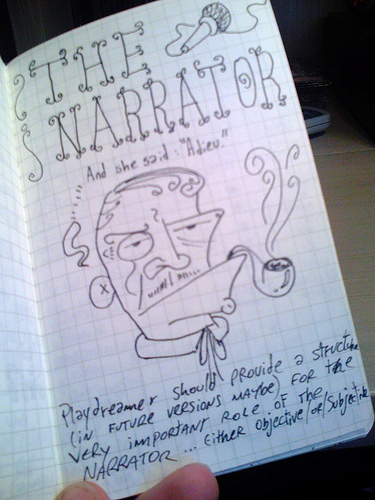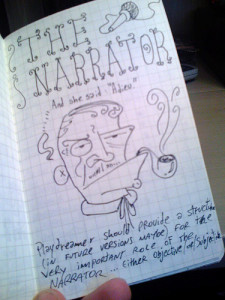I’m often asked about narrative: How do I know what tense to use to tell my story? In whose POV (*Point Of View) should I tell it? Should it be in first-person or third person…or second-person? (Wait, is there such a thing as second-person??)
Choosing a narrative isn’t as easy as some are maybe led to believe. At the same time, if you think too much about it, you can make it a lot more complicated than it needs to be. In terms of story-telling, narrative is very simple. It’s literally how you tell your story. It can also be who tells your story. (Think of a play, who does the story-telling? The narrator.)
But how do you choose a narrative? How do you know the best way to tell your story? The first thing to think about when formulating a narrative is: How do you envision this story being told?
Ideally the narrative for your story isn’t something you “think about” or “decide”. The narrative for your story is something you imagine.
A narrative is something you hear, something you don’t even need to formulate. At first. Once you have a first draft, you can formulate all you want – catch tense inconsistencies, problems with voice, perspective issues…. But before you even get to that point, you’ve got to get that first draft.
But, how do you find your narrative in your first draft? Oh, don’t worry about that. It just appears.
No, I’m not going all Harry Potter on you guys. We’re not apparating here.
Narrative is much more about stream-of-consciousness writing than it is about articulating a specific way of narrating. Even if you’re not writing from the POV of a character, you’re writing in some kind of voice, aren’t you? Narrative is really just all about voice. It may not be your voice; maybe it is, but that’s up to your story to decide. Once you allow this voice – whatever or whoever this voice is – to come through in your writing, it will seem as though it has just “appeared” out of nowhere.
If you’re wondering about narrative in terms of plot devices and character development – which you can usually focus on more in a second draft – here are some things to consider:
- How much are you keeping from your audience? If your story includes a secret, that either you are keeping or one of your characters is keeping from your readers, is there a POV or perspective that will best keep this secret hidden from your readers?
- What, or who, is the focal point of your story? When choosing character perspectives, always keep in mind that it will directly influence not only how you tell the story but how your audience sees the story. If you don’t see the world in the same way that say, your sister does, then your characters sure won’t experience the world in the same way, either. Character narratives can make or break the impact of your story, and can completely change how a reader experiences your story too. Think of The Great Gatsby. Do you think that story would have near the humility and grace that it does, if it were told from the POV of Gatsby himself instead of his friend, Nick Carroway? Nick’s distance from the story is actually what brings us closer to understanding Gatsby – who is the focus of the story – as a character. Think of what power there is in the outside perspective.
- Will this narrative truly highlight the story being told? There is something to be said for telling a story simply. Too much complication, and a reader tends to feel more confused than entertained. We read first and foremost because we want to be sucked into a world that’s unlike our own. If a story sacrifices that for the sake of upholding a narrative, then it has failed the reader. Always allow your story to tell itself from the narrative that makes your story – and your readers, and you – feel most alive.
The most important thing to keep in mind about narrative is: Don’t let narrative become a separate thing from your story. The way the words are strung together may be your “narrative” in a literal sense – but don’t forget that your narrative is really just your story being told. So relax, let the story tell itself, and your narrative will find its way. Then all you have to do is fix it in editing.
What is your own personal process for finding a narrative?
~
The photo featured with this post is by Santi Siri!
Check out more photos on Flickr.
~

